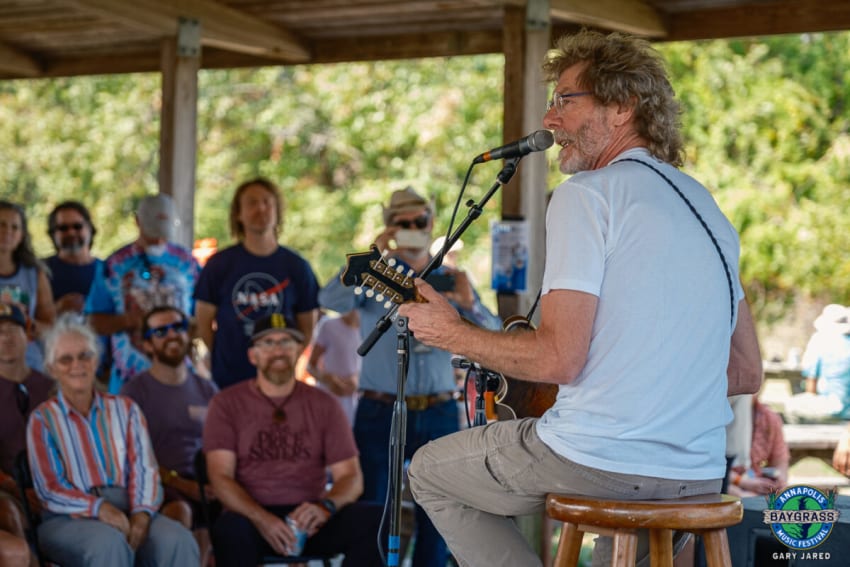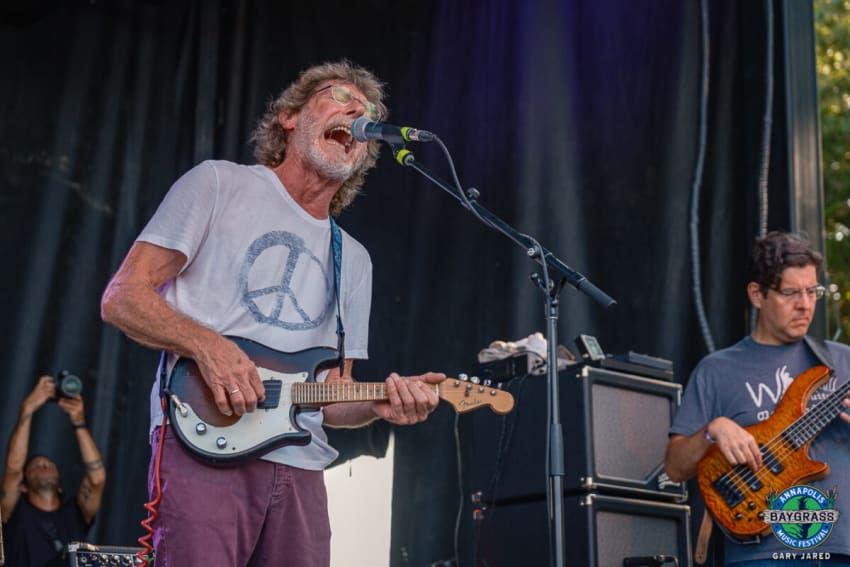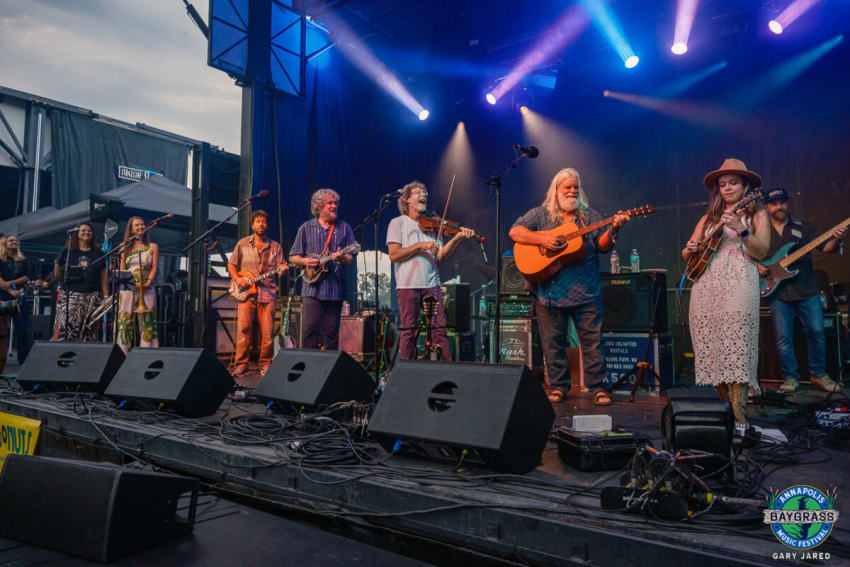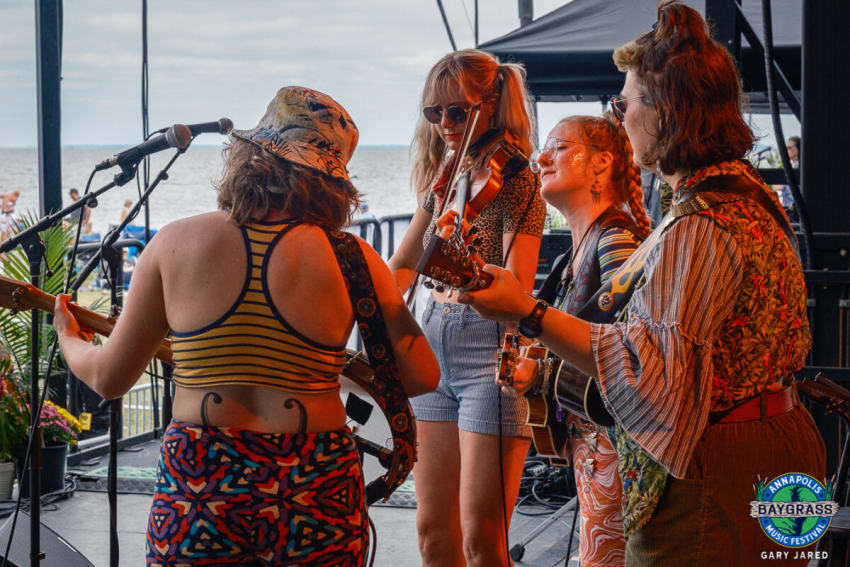Every Jam Saves The Bay: Collaborations Abound At 2nd Annapolis Baygrass Music Festival
The second annual event was held last weekend at Sandy Point State Park in Annapolis, Maryland.
By Matt Hoffman Sep 25, 2024 • 1:42 pm PDT

Photo by Jay Strausser
At the second annual Annapolis Baygrass Music Festival, set in Sandy Point State Park along the picturesque shores of the Chesapeake Bay, a formidable lineup of bluegrass artists presented two days’ worth of top-notch music in furtherance of a pair of good causes: environmental conservation and mental health awareness. The family-friendly festival’s motto is “Every Jam Saves the Bay,” which affects nearly 20 million people across six states and Washington D.C. and hosts more than 3600 species of fish, wildlife, and plants. They also say that “Every Jam Helps a Mind,” and through Baygrass, they did their part to save the Bay and help countless minds for the second year in a row.
The Origin of Baygrass
Baygrass was born from the founders’ deep love for the Chesapeake Bay and a passion for bluegrass music. Co-founder Ron Peremel grew up in Baltimore and regularly enjoyed the Bay. He moved to Boulder in the late 1990s, where he cultivated a greater environmental awareness and fell in love with bluegrass music, leading to decades of countless shows and festivals, including many a DelFest and Telluride. When he moved to Annapolis in 2012, he leaned into his passion for conservation and became actively involved with a variety of Bay conservation efforts, including the Chesapeake Bay Foundation and the Watershed Stewards Academy (WSA) and becoming a Master Watershed Steward.
For years, Peremel wanted to find a way to combine Bay conservation with something people love, eventually deciding to launch a beer garden to promote environmental awareness. Post-pandemic, his vision evolved into what would become Baygrass: a music festival designed to educate, inspire and protect, while presenting the best in bluegrass music and local cuisine. Peremel approached John Way, a friend-of-a-friend and U.S. Army veteran who leads the VA Way, a nonprofit that champions mental health awareness. (Way also had experience in operating bluegrass concerts and festivals.) Peremel also approached Ron Katz, a local attorney born and raised in Annapolis, and each of the men appreciated the others’ passion for music and good causes and set out to make Baygrass happen.
Advertisement
First Annual Baygrass: Proof of Concept (and Then Some!)
The first annual Baygrass festival, held in 2023, was a huge success. (The group had planned to hold the first festival in 2022, but Hurricane Ian thwarted the plans.) The lineup included long-tenured groups like Yonder Mountain String Band, Railroad Earth, Keller Williams and Melvin Seals and JGB, along with rising stars like Cris Jacobs and Fruition. Local musician John Bolten, on request of Ron Peremel, wrote “In the Water,” the official theme of Baygrass, and recorded it with his bluegrass/old-time band Geraldine, the Official Baygrass House Band, featuring Jacobs. (Bolten describes “In the Water” as a “gift song,” one that poured out of him.) The lyrics to “In the Water” appeared at all water filling stations at the festival.
Baygrass established a series of green practices to build a sustainable festival, featuring food and drinks from local vendors and using solar power wherever possible, as well as offering no single-use plastics and deploying a legion of green vest-wearing volunteers to stand at waste receptacles and help attendees sort their compost, recyclables and trash.
The group had set a high bar for themselves as they began to think about Baygrass 2024.

Photo by Taylor Lewis
Second Annual Baygrass: Raising the Bar
The founding team knew that Baygrass 2.0 was going to be big. “We had an 83% increase in ticket sales, with people coming from all over, including 32 states, plus Ontario and Montreal, Canada,” said Katz.
Two breweries, Pherm Brewing and Idiom Brewing, made beers just for the festival: Baytoberfest, a märzen, and Troubled Waters, a pale ale. As the team began to curate this year’s lineup, Thom Bloom (Director of Artist, Guest, and Partner Relations) wanted to provide unique experiences for artists and audiences alike across multiple genres of music.
Baygrass announced the 2024 lineup in April, with headliners and The Infamous Stringdusters. Baygrass 2024 also would feature Leftover Salmon, Sam Bush, Kitchen Dwellers, Daniel Donato's Cosmic Country, Sierra Hull, and Cris Jacobs, among many others, including a trio of artists-in-residence: Jennifer Hartswick and Natalie Cressman of TAB, and Ron Holloway, a local legend who’s played with everyone from Duke Ellington to Gil Scott-Heron, as well as Warren Haynes, Susan Tedeschi and Devon Allman. Collectively, the trio was dubbed “The BayBrass Horns.”
Geraldine opened the festival on Saturday. Bolten wears his influences – from Hazel Dickens to Doc Watson to Grateful Dead – on his sleeve, and they set the tone for the variety of bluegrass interpretations that the weekend would go on to exhibit. Next, the Montana-based The Lil Smokies treated the crowd to both original tunes and a variety of covers ranging from Bob Dylan and The Beatles to lesser known artists like John Fulbright, consistent with their recent wide-ranging series of singles.
Sierra Hull’s set, the first of the weekend to include a drummer (in the form of a standout performance by Mark Raudabaugh), got the crowd moving. Despite some technical difficulties, Hull shredded her mandolin to the delight of the crowd, featuring mostly original tunes and also covers of Tears for Fears (“Mad World,” performed more like the Gary Jules cover than the original) and Béla Fleck and the Flecktones (“Stomping Grounds”).

Photo by Jay Strausser
The day proceeded along like clockwork. As Hull mesmerized the crowd, Sam Bush led a workshop on the other side of the festival, discussing everything from his years with New Grass Revival to the definition of bluegrass, which he described as the music created and inspired by the many influential artists to play with Bill Monroe’s band over the years, including Flatt and Scruggs, Peter Rowan, and Del McCoury.
Bush and his band took the stage next, making clear from the get go that their set would take a broad view of what constitutes bluegrass music. Bush took to his mandolin, fiddle, and a Stratocaster mandolin that he described as “Eric Clapton’s guitar after taxes,” picking, bowing, and shredding the crowd into reverence. His banjo player wielded a synth banjo in the shape of a Telecaster and provided leads and some background organ sounds.

Photo by Gary Jared

Photo by Gary Jared
Next, Geraldine performed “In the Water” with Ron Holloway, before took the stage to present a high energy set of The Allman Brothers Band music. Hartswick and Cressman joined the band for “Southbound,” and Holloway joined for “Whipping Post.”
Leftover Salmon was the next act to take the stage, where Vince Herman and Drew Emmitt delivered an eclectic set of tunes as they’ve been doing for 35 years.
“What a great festival site, lineup and great great crew that make it all happen,” said Herman of Baygrass. “This one’s gonna be around a long time.” The BayBrass Horns joined for part of the set, including “The 420 Polka” and “Better,” as did Hull and Bush, on fiddle and electric mandolin.

Photo by Gary Jared
To close the night, Oteil Burbridge led his ensemble through two sets with Jason Crosby manning the keys in the absence of Melvin Seals, who was ill and unable to attend. The band interwove jams with originals and covers, sometimes slow and vibey, sometimes herky jerky, and always captivating. The BayBrass Horns joined for “Cats Under the Stars,” where at one point Holloway teased the Edgar Winter Group’s “Frankenstein.”
Both Oteil and Steve Kimock had unaccompanied musical moments, as did Tom Guarna, the other guitarist in the Friends, and they also treated the crowd to a cover of Nirvana’s “Lithium,” substituting “Friend of the Devil” lyrics throughout the performance. By the end of the second set, both the band and the fans were ready to call it a night. Herman put it well when he shared his view with JamBase that “Oteil’s set was soooooo good!”

Photo by Gary Jared
The second day of Baygrass was the first day of fall after the equinox, one of two times a year when the sun is exactly above the Equator. Opening the festival was local act The Dirty Grass Players, who shared that this would be their last show with banjo player Alex Berman, whose infant daughter was at the show, her mother holding her up for all to see. (“The Lion Queen,” the band joked on stage.) They played a variety of originals and covers, including an energetic cover of Lorde’s “Royals” and an instrumental hip-hop medley that included Eminem and Afroman.
Taking the stage next was Big Richard, the first band of the weekend that did not feature a guitar. Their set covered the spectrum of bluegrass, country, and old-time music, inviting “Brandy Clawhammer” (Baltimore banjo player Brad Kolodner, wearing a dress, in the spirit of the all-female band) to join for a song, and they brought the house down with a powerful rendition of Pink Floyd’s “Time,” full of high-gain, overdriven violin.
Brown-Eyed Women, an all-female Grateful Dead tribute band, performed tunes from a variety of eras, including late-era favorite “Just a Little Light,” along with a horn-augmented version of “Hard to Handle.” Across the festival, Way led a workshop with veteran and VA Way co-founder Gary Canteen, and the Anne Arundel City Health Department discussing mental and emotional challenges and 988, a 911-like resource for those in distress who may not want to reach out directly to the police.

Photo by Jay Strausser
Maryland native and repeat Baygrasser Cris Jacobs, an old friend of Way’s, took the stage late following some technical difficulties, but he didn’t waste a second. Jacobs was raised on bluegrass and released his first bluegrass album, One of These Days, earlier this year following a fortuitous DelFest backstage hang with Jerry Douglas, who would go on to produce the album. Jacobs started the set on lap steel, swapping that with electric and acoustic guitars throughout the set. Everybody jammed seamlessly, including Jacobs’ rhythm section of nine years and Bryan McDowell, who’s been playing fiddle, mandolin, and guitar with Jacobs for the last year, as well as Daniel Donato, who took a break from preparing for his own set to engage in some friendly – yet merciless – head-cutting with Jacobs.
The crowd buzzed with anticipation as Daniel Donato's Cosmic Country took the stage next. The band has been caught in a cycle of putting on great shows and generating well-earned recognition, most recently a feature on The Late Show With Stephen Colbert. Apropos of their name, they’ve got chops in both country and psychedelic music, and their singular blend of the two has caught the attention of fans across a wide range of musical styles.
As the band tore through their ever-growing catalog, the wind – or was it the intensity of the rocking? – blew Donato’s hat right off his head, as he traded licks with the Kitchen Dwellers’ Torrin Daniels, who sat in on banjo. The highlight of his set, as often is the case, was “Ghost Riders in the Sky,” which somehow sounds like an Ennio Morricone-penned sonic interpretation of the tornado scene in The Wizard of Oz. The band closed their set with a cover of “Respect,” led by keyboardist Nathan “Sugar Leg” Aronowitz and supported by The BayBrass Horns.

Photo by Jay Strausser
Next up were the Kitchen Dwellers, who have a history of supporting philanthropic efforts, including fisheries, recently performing in Alaska at Salmonfest, and mental health resources for musicians and donating $1 for each ticket they sell to Backline. They also have a big place in their heart for Maryland audiences.
“They’ve embraced us since our first tours,” said guitarist Max Davies. “Every time we’re here, someone invites us out for crab cakes.”
That’s how he got to know John Way, which ultimately led to the group’s joining the festival, where they brought a modern take on bluegrass, full of effects-driven guitar and banjo work by Davies and Daniels. The Dwellers’ mandolin player, Shawn Swain, is on break from touring, so Silas Herman, whose father Vince founded Leftover Salmon and performed at the festival the night before, expertly filled in. The band maintained the spirit of collaboration by inviting performances with BayBrass Horns, as well as Daniel Donato, who joined for a cover of “Timebomb,” by the Old 97’s.
To close the second night and entire festival, The Infamous Stringdusters took the stage and didn’t show any signs of weariness on the heels of their own Infamous Weekend at Pop’s Farm in Martinsville, Virginia, where fellow Baygrass billmates the Lil Smokies and Donato had performed as well. They kept the energy up across two sets of virtuosic bluegrass, with Jeremy Garrett’s soaring violin often leading the charge, and invited The BayBrass Horns to join for a cover of Harry Styles’ “As It Was,” where each player took leads that were playful, tasteful and fun. By the end of the night, everyone had a smile on their faces and went home happy.

Photo by Gary Jared
Every Jam Saves the Bay and Helps a Life
Baygrass’ mission is to provide education and funding to protect and restore the Chesapeake Bay and to raise mental health awareness. They host a variety of vendors, exhibitors, and workshops on topics ranging from music to mental health awareness and conservation. A percentage of all proceeds go to a variety of nonprofits aimed at Bay conservation (the Alliance for the Chesapeake Bay, the Oyster Recovery Partnership, and the Watershed Stewards Academy) and raising mental health awareness (the VA Way, sobar*, the Anne Arundel County Department of Public Health, the National Alliance on Mental Health, the National Council for Mental Wellbeing, and 988). These groups had the opportunity to educate festival attendees about their efforts. In 2023, Baygrass raised $30,000 for the Watershed Stewards Academy and sought to grow that total to $75,000 in 2024. As Baygrass has grown, so has their commitment to sustainability.
“People can see what we mean when we say, ‘Every Jam Saves the Bay,’” says Peremel. Walter Wright, the Baygrass Environmental Director, said that by providing filtered water stations and reusable metal cups, Baygrass reduced waste by the equivalent of 8,000 plastic bottles. He added, “Baygrass provided at-the-source sorting of compost, recycling and trash, including separate oyster shell collection and replanting in the bay (over 9,000 shells collected) with volunteers to educate/inform attendees and reduce contamination.”
When he’s not performing with Geraldine, Bolten is also the Chief of the NASA Hydrological Sciences Laboratory, where he works in water resource management and preservation all over the world, including in the Chesapeake Bay. He brought a group of scientists to the festival to discuss how they’re working to preserve the Bay and minimize the impact of farming, including by monitoring and modeling water quality and mapping invasive species in the region.
There’s no telling what’s in store for Baygrass 2025, but it’s worth seeing this festival that’s on a path to becoming the next household name in bluegrass festivals.

Photo by Jay Strausser
